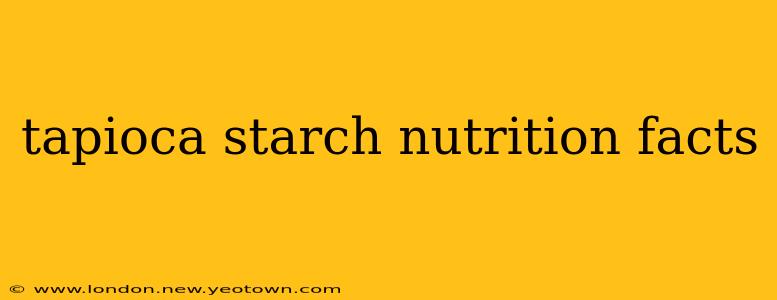Tapioca starch, also known as tapioca flour, is a fine, white powder derived from the cassava root. This seemingly simple ingredient plays a surprisingly significant role in countless cuisines and food products worldwide, from bubble tea to gluten-free baking. But beyond its culinary versatility, what are the actual tapioca starch nutrition facts? Let's delve into the details and uncover the nutritional profile of this popular starch.
What is Tapioca Starch Made From?
Before we dive into the nutritional breakdown, it's important to understand its origins. Tapioca starch is extracted from the cassava root (Manihot esculenta), a starchy tuber native to South America. The process involves washing, peeling, and grinding the root to extract the starch, which is then dried and refined into the familiar fine powder. This process removes most of the fiber and nutrients present in the original cassava root, resulting in a predominantly carbohydrate-based product.
Tapioca Starch Nutrition Facts: The Basics
A typical 100-gram serving of tapioca starch offers approximately:
- Calories: 350-400 calories (primarily from carbohydrates)
- Carbohydrates: ~90 grams (almost entirely starch)
- Protein: Trace amounts (negligible)
- Fat: Negligible
- Fiber: Negligible
It's crucial to note that tapioca starch is essentially pure carbohydrate, lacking significant amounts of protein, fat, vitamins, and minerals. This makes it a low-nutrient, high-calorie food.
Is Tapioca Starch Gluten-Free?
Yes, tapioca starch is naturally gluten-free, making it a valuable ingredient for individuals with celiac disease or gluten sensitivity. Many gluten-free recipes rely on tapioca starch to provide binding and thickening properties.
What are the Benefits of Tapioca Starch?
While not a nutritional powerhouse, tapioca starch does offer some benefits:
- Gluten-free option: Its gluten-free nature makes it a versatile ingredient in gluten-free baking and cooking.
- Thickening agent: It's an excellent thickening agent for sauces, soups, and puddings.
- Binding agent: It can bind ingredients together in baked goods and other recipes.
- Easy to digest: For some individuals, it may be easier to digest than other starches.
What are the Drawbacks of Tapioca Starch?
The lack of substantial nutritional value is the primary drawback. Overconsumption can contribute to weight gain due to its high calorie and carbohydrate content. It also has a high glycemic index, meaning it can cause a rapid spike in blood sugar levels.
Is Tapioca Starch Good for Weight Loss?
No, tapioca starch is generally not considered beneficial for weight loss. Its high-calorie and carbohydrate content, coupled with its low nutritional value, makes it a less-than-ideal choice for those aiming to shed pounds.
How is Tapioca Starch Different from Tapioca Pearls?
Tapioca starch and tapioca pearls are both derived from the cassava root, but they differ significantly in their form and usage. Tapioca pearls are small, chewy balls made from tapioca starch and water; they are primarily used in desserts like bubble tea. Tapioca starch, on the other hand, is a fine powder used as a thickener and binding agent in cooking and baking.
What are Some Good Alternatives to Tapioca Starch?
Depending on your culinary needs, several alternatives to tapioca starch exist, including cornstarch, arrowroot powder, and potato starch. Each offers slightly different properties in terms of thickening and binding capabilities.
Conclusion: Tapioca Starch – A Versatile but Limited Ingredient
Tapioca starch is a versatile culinary ingredient, especially for gluten-free cooking. However, its low nutritional value and high glycemic index necessitate mindful consumption. As with any ingredient, moderation is key. Understanding the tapioca starch nutrition facts allows for informed choices within a balanced diet. Remember to consult with a healthcare professional or registered dietitian for personalized dietary advice.

